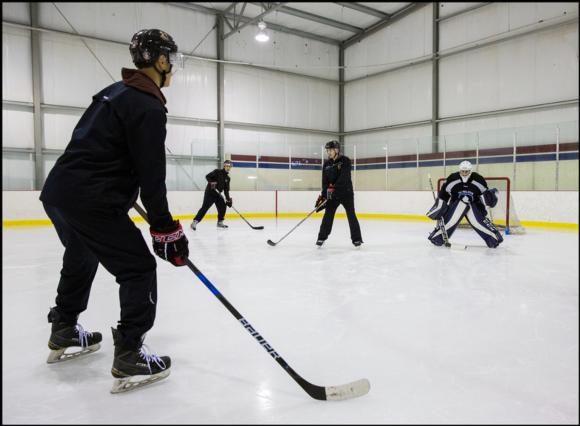Defend against common plays off the opposition rush
This is an excerpt from Hockey Goaltending by Eli Wilson,Brian van Vliet.
There are so many variations of offensive attacks that you need to be prepared for. The opposition attack is nonstatic. The players are coming at you, and you need to prepare yourself as the play develops in front of you. You need to have laser-like focus on the play coming off the rush and be prepared to defend it. Following, we discuss the most common plays that occur off the opposition rush and some techniques on how to defend them.
One-on-One
In a one-on-one situation, the opposing forward has two options. He can either shoot or try to go around the defenseman. Often, the opposing forward will try to use your defenseman as a screen and then shoot the puck with the intention of catching you off guard while your vision on the puck is impaired. If the opposition forward beats the defenseman wide, a breakaway situation will occur, and you will utilize the tactics discussed previously. Here are a few other key points for you in a one-on-one situation:
- Be aware of the shooter's options. Is he going to pull wide or shoot straight on through the screen?
- Don't let up. Often, the goaltender will think a shot won't take place because the defenseman has the play covered. You can be beaten with an unexpected shot.
- Make sure you have enough backward momentum in case the shooter pulls you across the crease.
- Make sure you maintain good gap control and do not get caught flat-footed.
Two-on-One
For many years, it was taught that when facing a two-on-one, the defenseman should take away the pass and leave the shot for the goaltender. With goaltenders now able to move post to post with much more efficiency, this coaching tactic is not always applicable. If facing a two-on-one, the opposing player coming down the wing has three options: he can shoot to score, shoot it off the goaltender to create a rebound, or pass it to his teammate.
You need to have discussions with your defenseman in practice about how you are going to position yourselves on a two-on-one. Is the defenseman going to play more in the middle or to the puck carrier's side? You should play slightly stronger to the puck carrier's side but be ready to play the pass (figure 6.4). Some coaches prefer their defenseman to play strong to the puck carrier, whereas others prefer the defenseman to play more toward the middle of the ice. There are still those who prefer the defenseman to take away the pass. As a goaltender, the coaching tactic chosen is out of your control. You need to hold your ground and be aware of the nonpuck carrier's position. If the nonpuck carrier is heading back door, then be ready to butterfly slide and take away the pass play. If the puck carrier shoots far side, you are already in a good position to make the save. If the opposition forward shoots far side, activate your stick to make the save. Here are a few other key points for you in a two-on-one situation:
- Maintain your angle on the shooter. If there is a pass option, play a little deeper in your net in preparation for a butterfly slide.
- Gauge the speed of the opposition skaters early. Know which hand the shooters are.
- Be ready to activate your stick on far-side shots to eliminate any potential rebound.

Figure 6.4 Two-on-one: The goaltender plays slightly stronger to the shooter's side.
More Excerpts From Hockey Goaltending
SHOP

Get the latest insights with regular newsletters, plus periodic product information and special insider offers.
JOIN NOW


